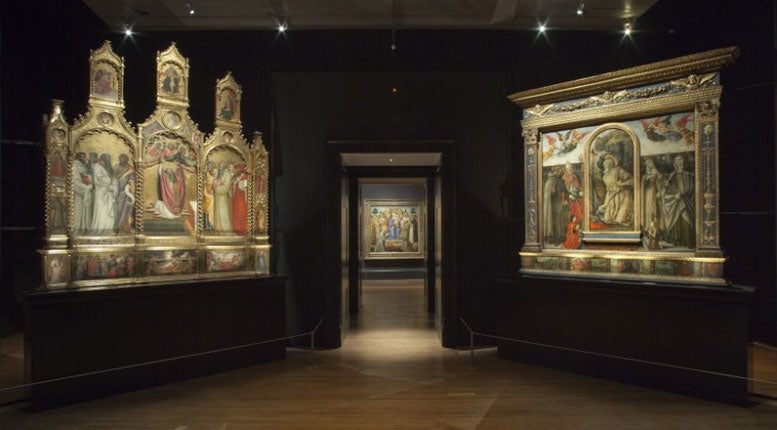Devotion by Design, National Gallery, London
Early religious paintings from the National Gallery's own treasury speak to a modern audience – and to each other

Facing you, as you walk into the second room of the National Gallery's new show, Devotion by Design, is a pair of altarpieces.
Or rather, a not-pair, their differences being the point of showing them together.
To the left is the Ascension of Saint John the Evangelist by Giovanni dal Ponte, a Florentine artist whose nickname came from the bridge by his studio; the altarpiece was made for a nunnery in Pratovecchio, probably in the early 1420s. As was usual at the time, the story it tells – the Bible says nothing of John's death at Ephesus, so his ascension is apocryphal – is organised by divine rank.
In the all-important central panel is the evangelist himself, being hauled up to heaven by a wry-looking Christ. In panels to right and left are attendant saints – John the Baptist, Peter, Catherine of Alexandria et al – and below, in those cartoon-strip side-bars known as predellas, are small scenes from St John's life: his vision of the Revelation, his (failed) boiling in oil. Dotted about the Gothic frame that holds these narratives together are various sub-narratives, squeezed into roundels and spandrels.
The altarpiece to the right of the doorway, made 70 years later, is a quite different kettle of fish. If Giovanni's ambition was to tell many stories, Francesco Botticini's is to tell one. It is of Saint Jerome – thus the altarpiece's title, San Gerolamo – who appears in traditional penitent's garb in a central sub-panel set into the work's single, large panel. Again, there are secondary figures: Pope Damasus and Saint Eusebius to the left, Saints Paula and Eustochium to the right, and, in the foreground, a pair of kneeling donors. Now, though, all these occupy the same, unified space, and that space is believable.
Five years after Giovanni dal Ponte had packed his altarpiece off to the nuns, Masaccio painted his Trinity on the wall of Santa Maria Novella in Florence. Devotional art was never the same again. The Renaissance had begun, and the way Man thought about himself – and thus about God, in whose image he was made – changed for ever. What looks like a pizza on the floor where Botticini's figures stand tells us all we need to know. It is a disc of porphyry, comes from Ancient Rome and is shown in perspectival recession. Here are the long-lost classical virtues of rationalism and logic, harnessed for the worship of God. Cleverness, too, had been made by Him, and altarpieces could now be clever.
And Botticini's is. By giving his picture-within-a-picture of St Jerome its own gilt frame, the artist sets up a sequence of overlapping realities. The framed image exists as a separate artwork for us, the viewer, but also for the painted saints who seem to study it: even holy martyrs, it says, can be moved by the power of art. The donors, both temporally and spatially, are in another reality again. Tiny beside the Olympian sacred figures, they are shown in silhouetted full profile. This archaism harks back to the bad old pre-Renaissance days of Giovanni dal Ponte, and intentionally so. Humanity, for Botticini, is still part of the Gothic old dispensation. Art and rationalism are what will bring about the new heaven on earth.
You could spend a happy half-hour walking between these two altarpieces, so being able to walk behind them doubles your pleasure. No artwork is simply the product of itself; all are shaped by patronal demands, by the limits (or otherwise) of medium and technique. The unadorned flip-sides of these works show a more mundane world, but a no less revealing one.
Artists in Giovanni's day were in thrall to the carpenters who put their multi-part structures together. Once a Gothic altarpiece was assembled, nothing could be changed: stiffness begat stiffness, orthodoxy, Orthodoxy. By contrast, Botticini's altarpiece is a wonder of modern engineering as well as of modern painting. The single outer frame offers a new flexibility of construction, which in turn allows for artistic experiment. The swappable predella panels in particular become a place where artists, free from patronal interference, can really get down and playful. Some of the most important leaps forward in Renaissance painting take place in that strip below the main event.
I haven't left room for the other wonders in this wondrous show, although there are many. All but a handful of the works in Devotion by Design come from the NG's own collection, but this is not a hard-nosed exercise in money-saving. A national gallery has a duty to educate, and, using its own works, this show does. There are odd omissions – if viewers need to be told what a chalice is, chances are they'll need help with Saint Eustochium – but otherwise, this is an entirely admirable exhibition: clever without being threatening, accessible without talking down; entirely worthy of its subject.
To 2 Oct (020-7747 2885)
Next Week:
Charles Darwent finds Frida Kahlo and Diego Rivera reunited once more at Pallant House
Art Choice
Catch The Cult of Beauty: The Aesthetic Movement 1860-1900 at the V&A in London, before it closes next Sunday. It brings together pre-Raphaelite painting, lavish interiors and beautiful books. At Tate Liverpool, a major exhibition of René Magritte entitled The Pleasure Principle pleasingly lives up to its name (until 16 Oct).
Join our commenting forum
Join thought-provoking conversations, follow other Independent readers and see their replies
Comments
Bookmark popover
Removed from bookmarks